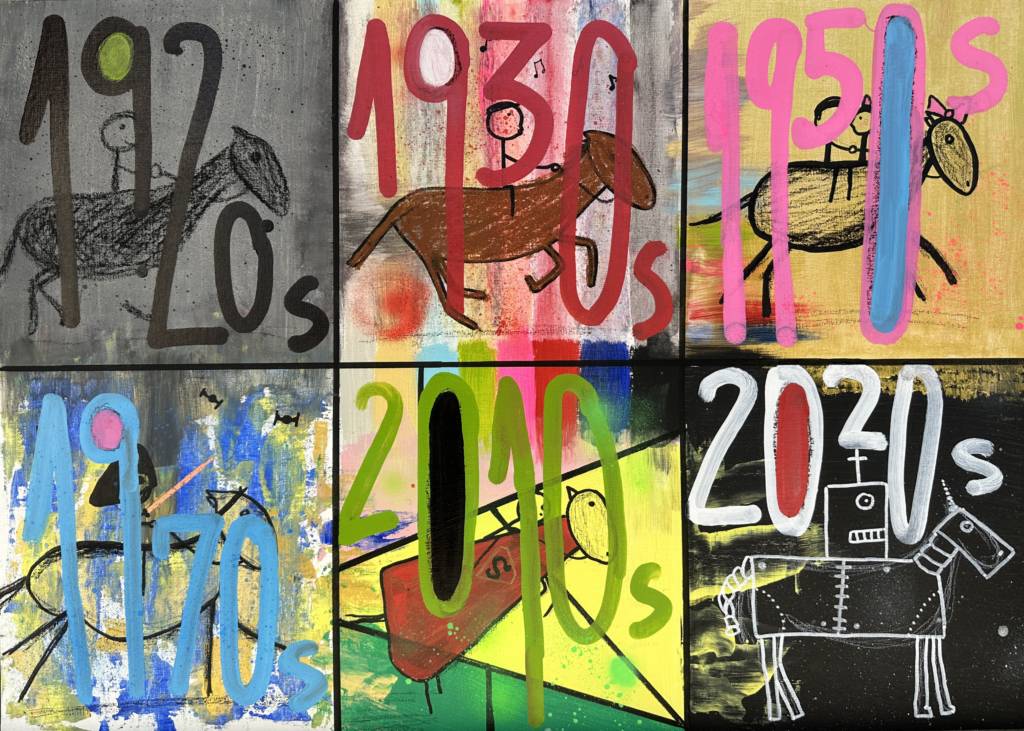Title: The Hi-story of cinema
Artist: Monica Dumitrescu
Country: Romania
A pioneer of innovation in art, she brings to the forefront reused elements such as newspapers, old fabrics, and other “waste,” transforming them into true masterpieces. This not only highlights her remarkable artistic abilities but also emphasizes her commitment to sustainability. The artist demonstrates that art is not confined by traditional materials and that only imagination limits human creativity.
Monica’s influences from street art and the field of contemporary art are reflected in every detail of her works. Through her expressive and authentic painting, she not only creates but also communicates, connecting with viewers on a profound level.
Artist’s Vision:
To underline the importance of the history that led to the beginning of cinema, I used a
drawing of a horse in motion (reference to The Horse in Motion – by Eadweard Muybridge).
The naive representations of the horses and the horsemen make reference not only to the cave paintings, as symbols of the beginning of art, but also to the importance of history to children (to know what brought us to this moment). Another thing I wanted to underline is that we, as grownups, need to keep our curiosity alive and use it as an ongoing learning curve (same as children do).
The artwork is split in six squares, each representing a key cinematographic moment:
1. Black and white, mute films – expression
2. Color films and introduction of sound in cinema – perspective
3. The golden age of international cinema – expansion
4. The introduction of special effects and the impact of martial art movies – confidence
5. The superhero movies and adaptation of comic books in cinema – belief
6. The pandemics and AI’s impact on cinema – reshuffle
Each square’s background passing on to the other as well as the color combination of the numbers shows that the past of the cinema (from technology, to acting, storytelling, vision, etc) will always have an impact on the future.
The bold representation of the decades partially covering each square is meant to increase the curiosity of “looking behind the obvious”, as well as to have a bigger impact on the viewer. It’s something that stays with you, something that will make you search on your own.

As I used to be part of film festivals, the first thing that came to my mind here is festival posters, especially with these years, which look like the years of different editions, with some sort of theme, like the bear on Berlinale posters. Although I watched films from each of the eras shown in this artwork, I feel not lucky enough that I didn’t live in most of them. I would have loved to witness the transitional period between the silent films and the talkies, and then between the black and white and the colors. These were the times of the explorations and trials, establishing some roles and breaking them soon after to create new ones, discovering what matters for the audience, and above all the attempt to create what we now call art of cinema. The good side is that after all these different periods, the filmmakers are still going back and forth between different styles and genres, there is no place for the word “discontinued”. We can still watch black and white films till now, there are many attempts -especially in short films- for doing silent films, and after we thought some genres like musicals or westerns are dead for good, they were revived by modern approaches. I have to say that I’m curious about the last panel, the AI era, and how it is going to affect this industry, we’re still in the very early stages of this period, yet we can see the conflicts that resulted from the use of AI, so what’s coming up for this art? – Andrew Mohsen, curator
